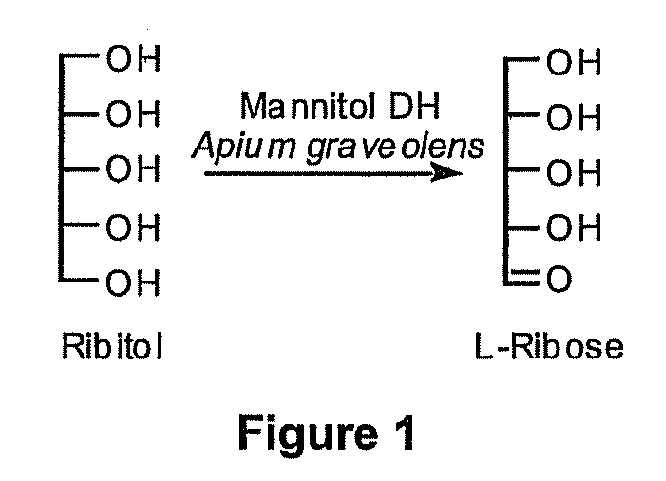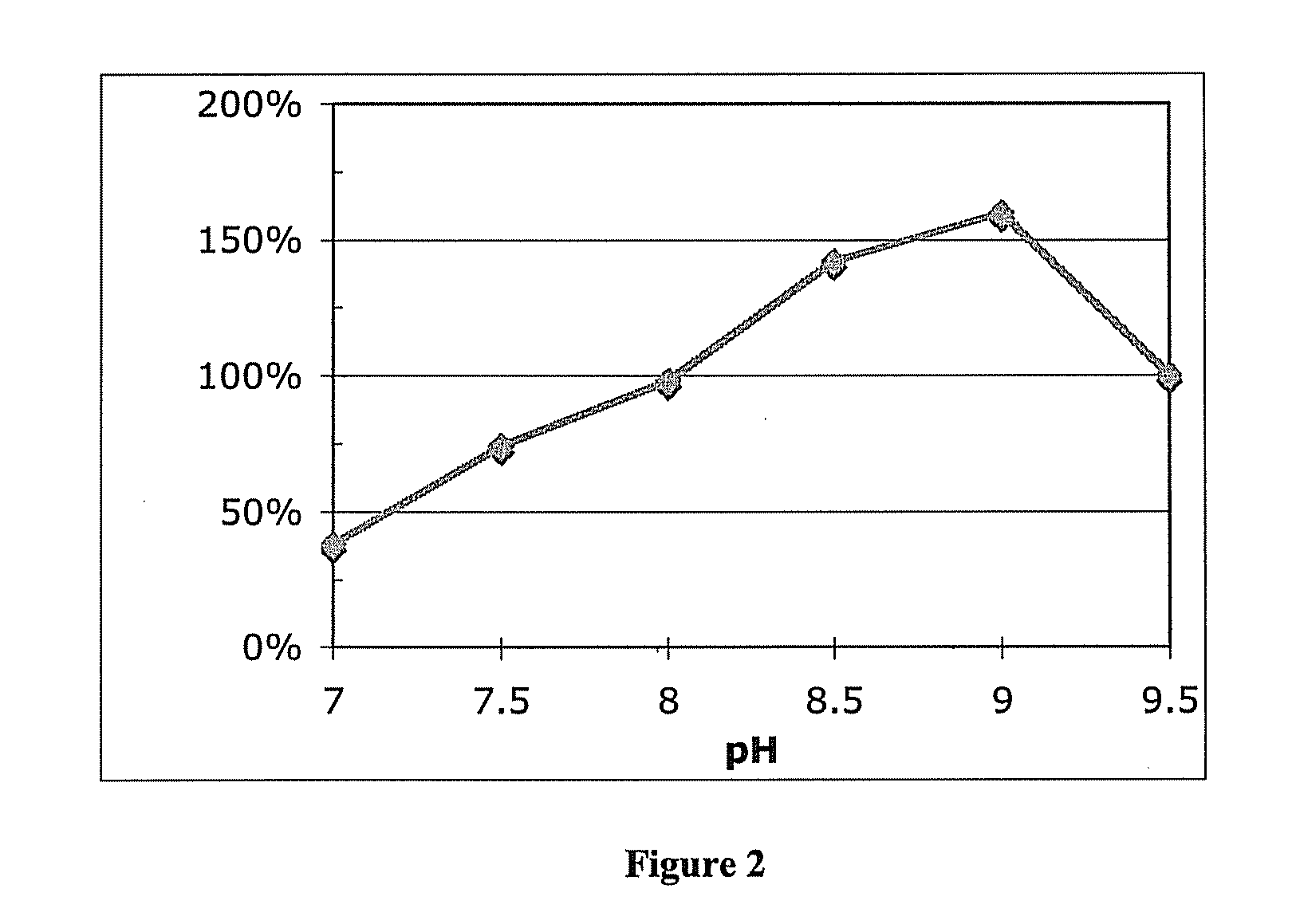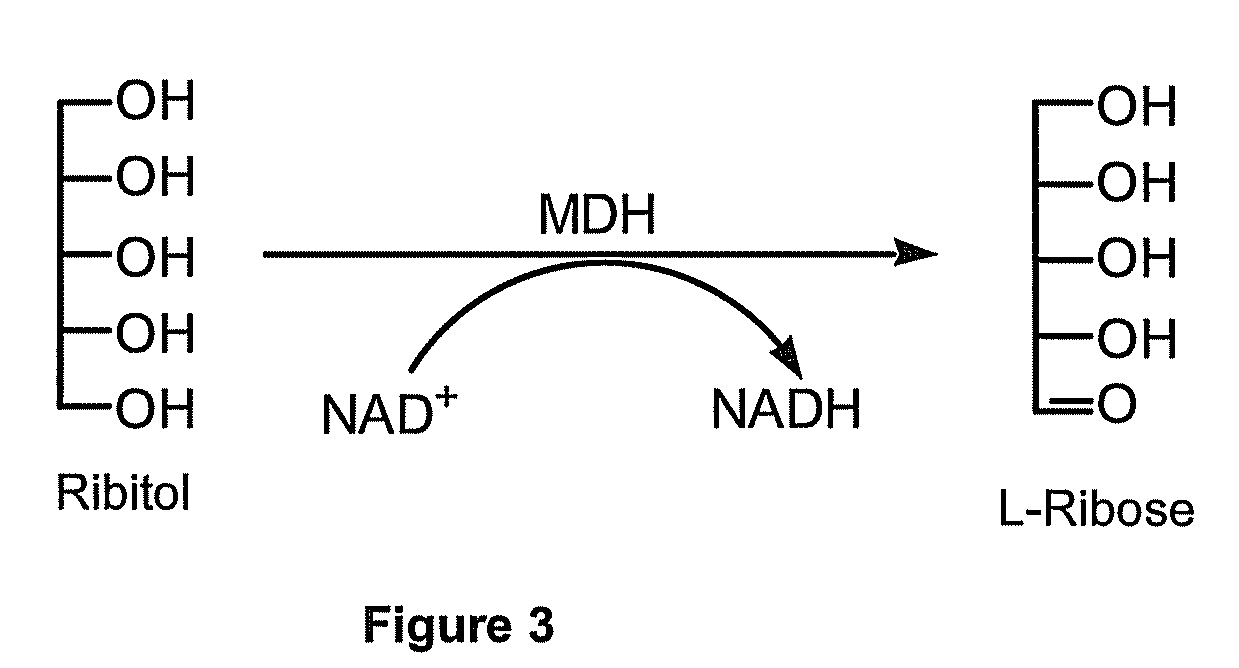Production of l-ribose and other rare sugars
a technology of l-ribose and rare sugars, which is applied in the field of production of l-ribose and other rare sugars, can solve the problems of increasing the cost of life-saving drugs, less readily available l-ribose, and only being used as starting materials for new biochemical and pharmaceutical compounds, so as to improve the production of l-ribose
- Summary
- Abstract
- Description
- Claims
- Application Information
AI Technical Summary
Benefits of technology
Problems solved by technology
Method used
Image
Examples
example 1
Expression of mannitol-1-dehydrogenase
[0073]The goal of this experiment was to express active MDH in E. coli and test this activity for the production of L-ribose from ribitol. The sequence of MDH is shown in SEQ ID NO:2. An MDH gene was synthetically constructed for expression E. coli. Specifically, the primary DNA sequence of the gene was optimized for codon usage and the removal of potentially hindering secondary structure of the RNA coding sequence. See, SEQ ID NO:1. This gene was cloned into a pTTQ18 expression plasmid, a pUC-based plasmid containing an inducible tac promoter. The E. coli BL21 strain was then used for expression of SEQ ID NO:1. Software packages, such as, GeneOptimizer® are available that can provide sequences having optimized codon usage and hindering secondary structure removed.
SEQ ID NO: 1ATGGCGAAAAGCAGCGAAATCGAACACCCGGTGAAAGCGTTTGGTTGGGCGGCACGTGATACCACCGGTCTGCTGAGCCCGTTCAAATTTAGCCGTCGCGCGACCGGCGAAAAAGATGTGCGCCTGAAAGTGCTGTTTAGCGGCGTGTGCCACAGCGATCACCACATGATCC...
example 2
Metal Requirements Including Inhibition
[0083]While not explicitly described in the literature[37-39], Apium gravelons mannitol-1-dehydrogenase (MDH) requires divalent metal ions, particularly Zn2+ ions, for activity. The presence of ZnSO4 increases MDH activity. Cells expressing MDH were grown in rich media were harvested and lysed with BUGBUSTER® protein extraction reagent, Novagen, Madison, Wis. MDH activity was then tested with increasing concentrations of ZnSO4 in the presence of D-mannitol and NAD cofactor at pH 9.0. See, FIG. 11.
[0084]MDH activity showed a 50% increase with the addition of 1 μM Zn2+ ions compared to no added zinc. Concentrations above 1 μM showed inhibition. High concentrations of other divalent metals are also inhibitory. The addition of 0.1 mM NiSO4 also inhibits MDH activity approximately 50% compared to MDH without NiSO4 added.
[0085]The metal requirement of MDH can also be seen in the growth media preparation for a fermentation bioconversion. Defined growt...
example 3
Temperature Vs. Activity and Stability Studies
[0087]The recombinant MDH was tested for activity at various temperatures. Lysates containing expressed MDH were incubated with D-mannitol and NAD at pH 9.0. Activity was measured by measuring the increased NADH concentration spectrophotometrically at A340nm. MDH showed maximal activity at approximately 39° C. See, FIG. 12.
[0088]The thermostability of recombinant MDH was also tested. Lysates containing MDH were incubated at various temperatures. Aliquots of MDH were removed at various times to measure MDH activity using the assay described above. See, FIG. 13.
[0089]Most MDH activity was lost after four hours of incubation, except at 25° C. The loss may be partially due to proteases present in the lysates. However, this experiment probably gives a good representation of the overall thermostability of the MDH considering the overall speed of the degradation. Purified MDH can be used to remove the potential for protease degradation.
PUM
| Property | Measurement | Unit |
|---|---|---|
| temperature | aaaaa | aaaaa |
| temperature | aaaaa | aaaaa |
| temperature | aaaaa | aaaaa |
Abstract
Description
Claims
Application Information
 Login to View More
Login to View More - R&D
- Intellectual Property
- Life Sciences
- Materials
- Tech Scout
- Unparalleled Data Quality
- Higher Quality Content
- 60% Fewer Hallucinations
Browse by: Latest US Patents, China's latest patents, Technical Efficacy Thesaurus, Application Domain, Technology Topic, Popular Technical Reports.
© 2025 PatSnap. All rights reserved.Legal|Privacy policy|Modern Slavery Act Transparency Statement|Sitemap|About US| Contact US: help@patsnap.com



